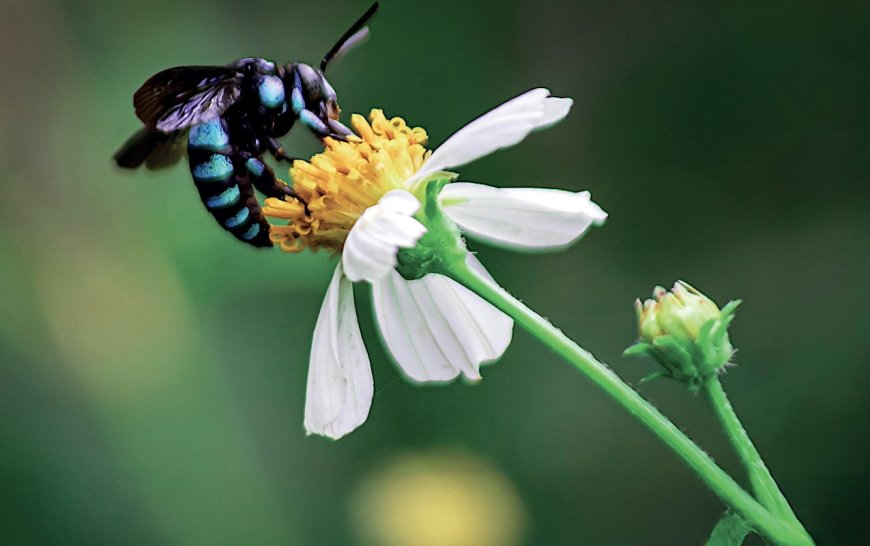Experts Identify Emerging Threats to Bees, From Wars to Microplastics and Light Pollution
United Nations World Bee Day is May 20, and a new report from Bee:wild — a science-led campaign to save bees and other pollinators worldwide — outlines the 12 biggest emerging threats to bees over the next five to 15 years. Among the emerging threats to pollinators identified by 10 leading experts in the report […] The post Experts Identify Emerging Threats to Bees, From Wars to Microplastics and Light Pollution appeared first on EcoWatch.

United Nations World Bee Day is May 20, and a new report from Bee:wild — a science-led campaign to save bees and other pollinators worldwide — outlines the 12 biggest emerging threats to bees over the next five to 15 years.
Among the emerging threats to pollinators identified by 10 leading experts in the report — Emerging Threats and Opportunities for Conservation of Global Pollinators — are war zones, street lights and microplastics.
“Identifying new threats and finding ways to protect pollinators early is key to preventing further major declines,” said lead author of the report Simon Potts, a University of Reading professor of biodiversity and ecosystem services who is chair of the Bee:wild Scientific Advisory Board, in a press release from University of Reading. “By acting early, we can reduce harm and help pollinators continue their important work in nature and food production. Various conservation opportunities already exist and more are emerging. This is not just a conservation issue. Pollinators are central to our food systems, climate resilience, and economic security. Protecting pollinators means protecting ourselves.”
Pollinators like bees, bats, butterflies and some birds are essential to nature and the world’s food supply, with nearly 90 percent of all flowering plants and more than three-quarters of the planet’s major crops dependent on them. Pesticides, habitat loss, invasive species and climate change have led to their severe decline, causing some bee species to go extinct.
A dozen emerging threats to pollinators, ranked by novelty, then impact, from highest to lowest, include:
- Wars and conflicts, which force nations to grow fewer crop varieties, leaving pollinators without diverse food sources.
- Microplastic pollution, which can reduce the health and lifespan of pollinators.
- Poorly planned tree planting to meet net zero goals; planting trees can help or harm nature, depending on which types are planted and where.
- Antibiotic pollution that can contaminate beehives and honey, affecting pollinator behavior such as reducing foraging and flower visits.
- Air pollution like ozone and nitrogen that can make pollinator survival, growth and reproduction more difficult.
- Increased indoor farming that can reduce wild pollinators’ natural habitat and spread disease by introducing managed pollinators to wild populations.
- A higher demand for mining materials such as cobalt and lithium used in batteries, which damages water and land, presenting another threat to pollinators.
- Pesticide cocktails, which weaken pollinators who are increasingly threatened by dangerous mixes of different pesticides, especially in developing countries.
- Artificial light at night, which confuses pollinators and reduces flower visits by moths and other nocturnal insects by 62 percent.
- Pollution from toxic heavy metals such as mercury and cadmium that can harm the health, behavior and survival of pollinators.
- Larger and more frequent wildfires, in combination with other threats, which destroy pollinator habitats and make recovery more difficult.
- Regional loss of pesticide tracking, which can lead to overuse of these toxic chemicals that kill pollinators, remove floral resources, lead to resistance in pests and damage the environment.
“We were already sounding the alarm on the decline of our pollinators, but this new report underlines that the range of threats are expanding. Rather than being filled with hopelessness, the purpose of the Bee:wild campaign is to fuel awareness, urgency and give everyone agency. There’s a lot we can all do to help save our pollinators, in our homes and everyday lives. Planting flowering plants to feed them, providing outdoor shelter and considering healthier diets like plant-based as well as pesticide-free, all matter a lot,” said Eva Kruse, executive director of Bee:wild. “It’s getting harder for our pollinators but we can all play a part in protecting them and building a sustainable future for all living things.”
The report also highlights measures we can take to safeguard pollinators and reverse their decline.
Some of these include stronger antibiotic use laws that could limit antibiotic pollution, particularly in areas with no restrictions; building more solar farms that double as well-designed, pollinator-friendly habitats; agricultural and trade policies that promote low-pesticide products and encourage farmers to use fewer pesticides; efforts focused on protecting native stingless bees, which are key pollinators in the tropics; more effective global policies and international regulations and laws, such as the European Union’s Nature Restoration Regulation, to support the protection of pollinators and reduce carbon emissions; and solutions that benefit multiple ecosystem services — pollinator protections can simultaneously improve water storage, soil health and carbon capture.
“The choices we make today will shape the future – not only for pollinators, but for all life on Earth. Together, we can ensure that these remarkable species continue their vital work, sustaining the natural world that sustains us all,” said Razan Khalifa Al Mubarak, board member of Re:wild — the nature conservation organization behind the Bee:wild campaign — and president of the International Union for Conservation of Nature, who wrote the foreword to the report.
The post Experts Identify Emerging Threats to Bees, From Wars to Microplastics and Light Pollution appeared first on EcoWatch.



















































